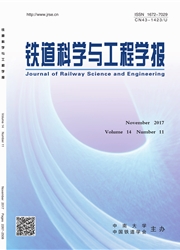

 中文摘要:
中文摘要:
为研究外接式钢桁-槽型梁组合桁架节点的受力性能、破坏模式以及极限承载力,对缩尺比例为1∶3的节点模型进行单调水平静力加载实验。介绍节点的模型设计、加载过程和测点布置情况;利用混凝土上弦杆自由端中点测得的位移绘出荷载-位移曲线得出外接式节点的极限承载力;同时对比各部件有限元分析结果,找出节点试验的薄弱部分,并提出相应的改进意见。研究结果表明:节点承载力较高,PBL剪力键传力效果明显;在不改变原缩尺比例的情况下通过在钢腹杆内增加12 mm厚的加劲肋能有效提高腹杆稳定性与节点极限承载力。研究成果可为以后实际工程设计以及理论研究提供帮助。
 英文摘要:
英文摘要:
To research the mechanical behavior, failure mode and ultimate bearing capacity of steel truss -trough girder composite truss joints, the monotonous static horizontal load was applied to the model gradually whose reduced -scale was 1: 3. The design of model, loading process and arrangements of measuring points were described in the first part of the thesis. The ultimate bearing capacity of the external node was calculated by analyzing the load - displacement curve of the free terminal of the concrete chord midpoint obtained by the measured displacement. Simultaneously, the aim is to find out the weak part of the node by contrasting the results obtained from the finite element analysis and propose appropriate improvements. The results indicate that the bearing capacity of node can meet the requirement of bearing capacity, and the PBL connector holds a good capability to transmit force. When the reduced -scale remains unchanged, adding a 12 -millimeter- thick stiffener can effectively improve the stability of the belly bar and the ultimate bearing capacity of the node. The research results can provide help for the later theoretical research and practical engineering design.
 同期刊论文项目
同期刊论文项目
 同项目期刊论文
同项目期刊论文
 期刊信息
期刊信息
